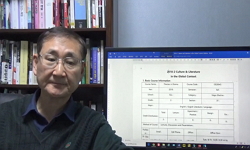This paper studies Ann Hamilton's performance/instillation works, which employ various ready-made and found objects and humans engaged in seemingly mundane activities. In straddling between performance and installation, her works tend to blur the boun...
http://chineseinput.net/에서 pinyin(병음)방식으로 중국어를 변환할 수 있습니다.
변환된 중국어를 복사하여 사용하시면 됩니다.
- 中文 을 입력하시려면 zhongwen을 입력하시고 space를누르시면됩니다.
- 北京 을 입력하시려면 beijing을 입력하시고 space를 누르시면 됩니다.
https://www.riss.kr/link?id=A82394323
- 저자
- 발행기관
- 학술지명
- 권호사항
-
발행연도
2010
-
작성언어
Korean
- 주제어
-
등재정보
KCI등재
-
자료형태
학술저널
- 발행기관 URL
-
수록면
223-251(29쪽)
- DOI식별코드
- 제공처
- 소장기관
-
0
상세조회 -
0
다운로드
부가정보
다국어 초록 (Multilingual Abstract)
Ironically, however, the reception of Hamilton's work reveals that viewers take her works otherwise. 'With all the aural, tactile, and olfactory distractions that draw their attention, the viewers of Hamilton's work tend to take a position that has been primarily understood as that of the beholder of Modernist painting. Far from being "awakened" by the work into the surroundings, the viewers are submerged into a state of absorption as their aesthetic response. Many critics duly note the contemplative aspects of Hamilton's work, using the terms such as 'meditative' 'nostalgic' 'religious' and even 'sublime', that have been the words describing the traits of modernist painting.
Reading in parallel with the receptions of modernist painting articulated by Michael Fried, this paper will argue the unique qualities of Hamilton's performance/instillation that challenge the binary opposition of modernist and postmodernist aesthetics.
This paper studies Ann Hamilton's performance/instillation works, which employ various ready-made and found objects and humans engaged in seemingly mundane activities. In straddling between performance and installation, her works tend to blur the boundary drawn between the two distinct artistic practices. Hamilton's creative efforts can be also considered as a critique of what can be seen as the dominance of sight in visual art by allowing other senses such as smell, sound, and touch to participate in the making and experience of her art These qualities, the blurring of genre and non-ocularcentric treatment of materials, can be called postmodern in the sense that they take issue with Greenbergian Modernism, which has championed the visuality and the purity of separate artistic practices on the basis of their own material conditions.
Ironically, however, the reception of Hamilton's work reveals that viewers take her works otherwise. 'With all the aural, tactile, and olfactory distractions that draw their attention, the viewers of Hamilton's work tend to take a position that has been primarily understood as that of the beholder of Modernist painting. Far from being "awakened" by the work into the surroundings, the viewers are submerged into a state of absorption as their aesthetic response. Many critics duly note the contemplative aspects of Hamilton's work, using the terms such as 'meditative' 'nostalgic' 'religious' and even 'sublime', that have been the words describing the traits of modernist painting.
Reading in parallel with the receptions of modernist painting articulated by Michael Fried, this paper will argue the unique qualities of Hamilton's performance/instillation that challenge the binary opposition of modernist and postmodernist aesthetics.
목차 (Table of Contents)
- Ⅰ. 머리말
- Ⅱ. 해밀턴의 오브제/설치/퍼포먼스
- Ⅲ. 관람자 : 몰입과 각성 사이
- Ⅳ. 맺음말
- 참고문헌
- Ⅰ. 머리말
- Ⅱ. 해밀턴의 오브제/설치/퍼포먼스
- Ⅲ. 관람자 : 몰입과 각성 사이
- Ⅳ. 맺음말
- 참고문헌
- Abstract
동일학술지(권/호) 다른 논문
-
- 현대미술사학회
- 진휘연(Jin Whui-yeon)
- 2010
- KCI등재
-
- 현대미술사학회
- 김향숙(Kim Hyang-ssok)
- 2010
- KCI등재
-
- 현대미술사학회
- 정은영(Jung Eun-young)
- 2010
- KCI등재
-
마르셀 뒤샹의 〈에탕 도네〉에 나타난 에로티시즘의 전략과 ‘앤드로지니’의 차용
- 현대미술사학회
- 현수정(Hyun Soo-jung)
- 2010
- KCI등재





 KCI
KCI DBpia
DBpia



